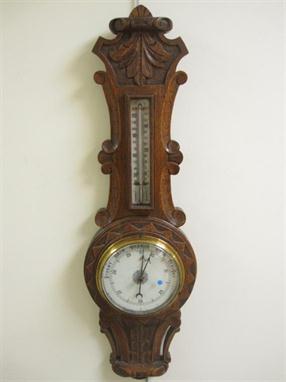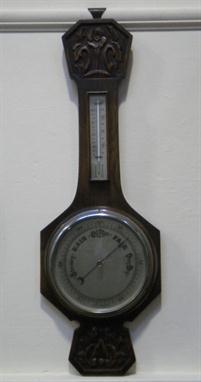A Victorian mahogany mercury wheel barometer. S. Lelli, Newport, Isle of Wight, mid 19th century, The 6 inch silvered scroll centre engraved circular register calibrated in barometric inches and with the usual observations, beneath ebonised reeded bordered convex mirror and arched alcohol Fahrenheit scale thermometer and hygrometer to the swan neck pediment, the rounded base inset with a spirit level signed S. LELLI, NEWPORT 94cm (37ins) high. S. Lelli is recorded on Banfield, Edwin BAROMETER MAKERS AND RETAILERS 1660-1900 as working from Newport, Isle of Wight 1839-55.
60594 Preisdatenbank Los(e) gefunden, die Ihrer Suche entsprechen
60594 Lose gefunden, die zu Ihrer Suche passen. Abonnieren Sie die Preisdatenbank, um sofortigen Zugriff auf alle Dienstleistungen der Preisdatenbank zu haben.
Preisdatenbank abonnieren- Liste
- Galerie
-
60594 Los(e)/Seite
A fine and rare George III mahogany free-standing mercury pillar barometer. Nairne and Blunt, London, late 18th century, The arched silvered scale fitted to a rotating brass table to allow rotation around the large bore mercury tube, with rack and pinion adjusted vernier and pivoted mirror behind to allow accurate observation of the level beneath signature NAIRNE & BLUNT, LONDON to arch, the fluted column upright with flared capital and moulded base with lift-off front section secured by a clasp formed as a dummy keyhole to reveal interior with mercury tube of smaller diameter packed by cotton wadding, the two stage plinth incorporating up-sliding cover for the sealed boxwood cistern above moulding to waist and double skirt to base, 167cm (67.75ins) high overall. The collaboration between Edward Nairne and his former apprentice Thomas Blunt is recorded in Banfield, Edwin BAROMETER MAKERS AND RETAILERS 1660-1900 as established in 1774 and lasting until 1793. Edward Nairne was born in 1726 and apprenticed to the celebrated instrument maker, Matthew Loft, in 1741. Latterly he worked from 20 Cornhill and published numerous booklets on navigational, pneumatic and astronomical instruments. In 1776 Nairne devised a marine barometer with a restriction to the bore of the mercury tube which served to dampen the oscillation of the mercury, he was elected Fellow of the Royal Society in 1776 and died 1806. Thomas Blunt was apprenticed to Edward Nairne in 1760 with whom he formed a loose partnership in 1774, perhaps for mutual convenience as his premises were next door to Nairne`s at 22 Cornhill. Blunt designed some of the components for the `New Barometer` devised by the Portuguese Scientist J.H. Magellan for measuring altitude, and latterly became instrument maker to George III. In 1793 he took his son, also named Thomas, into partnership and subsequently relocated to 136 Minories in 1814, he died in 1822. The current lot is highly unusual as it takes the form of a free-standing pedestal designed to be fixed to the floor with a scale that can be rotated for viewing from any angle, the mirror attached to the rear of the scale enables the level to be sighted precisely. The non-portable and accurate nature of the instrument coupled with a finely executed case suggests that it was probably commissioned for a wealthy patron perhaps for use in a private laboratory.
A fine George III mahogany stick barometer. Dollond, London, circa 1800. With broken triangular pediment above recessed silvered vernier scale calibrated in barometric inches, with the usual observations and signed Dollond, London near the upper margin behind hinged glazed brass door, the waisted caddy moulded trunk inset with a large Fahrenheit scale mercury thermometer behind a conforming brass framed door, the rounded base with moulded circular cistern cover and vernier adjustment screw to base, 102cm (40ins) high. Peter Dollond is recorded in Banfield, Edwin BAROMETER MAKERS AND RETAILERS 1680-1860 as born 1730 and died 1820. He was the son of John Dollond, a Huguenot silk weaver and started business as an optician in 1750. He was joined by his father in 1752 until his death in 1761, and then by his brother, John, until his death in 1804. The family business was continued by Peter Dollond`s nephew, George Huggins, who changed his name to Dollond. George Dollond became instrument maker to William IV and Queen Victoria, exhibited at the Great Exhibition in 1851 and died 1856.
A mid 19th century mahogany boxwood and ebony line strung wheel barometer by J Pini, 13 Baldwins Gardens, Holbourne, the 10 inch silvered register under a broken swan-neck pediment hygrometer, alcohol thermometer, and butler`s mirror over a spirit level to the base, 109cm high For details of the condition of this lot please contact the auctioneer.
-
60594 Los(e)/Seite














































